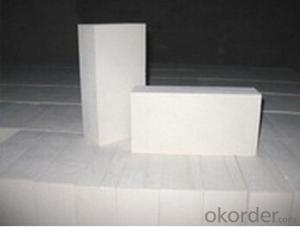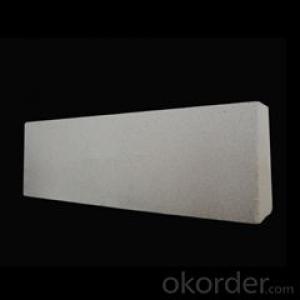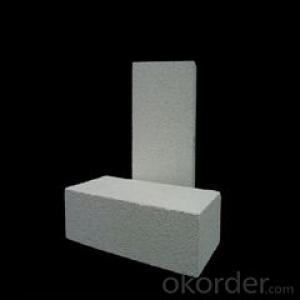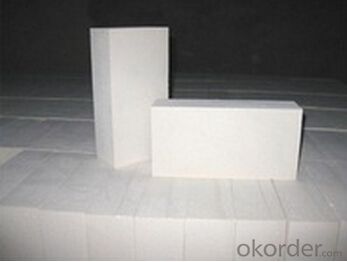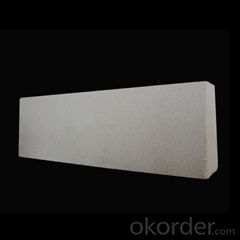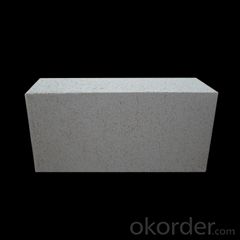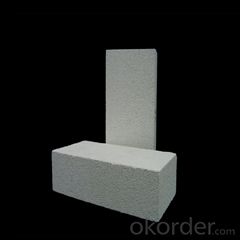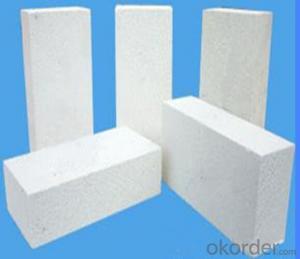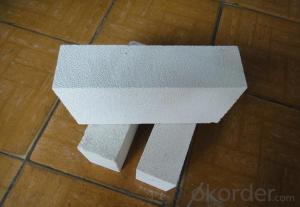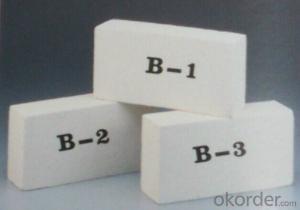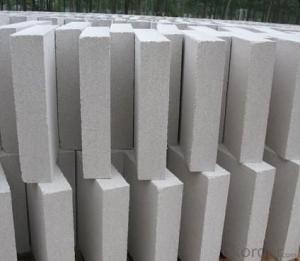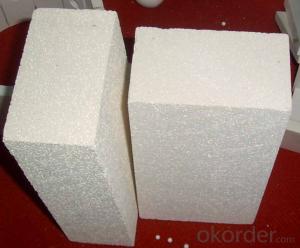Refractory mullite insulating refractory brick JM 93
- Loading Port:
- Shanghai
- Payment Terms:
- TT OR LC
- Min Order Qty:
- 5000 kg
- Supply Capability:
- 10000 kg/month
OKorder Service Pledge
OKorder Financial Service
You Might Also Like
Refractory mullite insulating refractory brick JM 23
Okorder series heat insulation brick
Okorder series thermal insulation brick is an effective, energy saving, low carbon, environmental protection advanced, according to the ASTM standard manufacturing products. Okorder series products are best Li Ning and insulation in all types of industrial furnaces in the metallurgical field, aluminum, petrochemical, electric power and glass ceramic materials. They can be used as part of the working layer of thermal insulation or non - melting. Products have been widely used in the following furnace, achieved satisfactory results.
Application of heat preservation brick
Metallurgical Industry: blast furnace, hot blast furnace, heating furnace, etc..
Petrochemical Industry: ethylene cracking furnace, hydrogen production furnace, primary reformer, heating furnace, etc..
Ceramic industry: roller kiln, kiln, etc..
Glass industry: glass furnace regenerator, etc.
Carbon industry: carbon furnace, etc..
Aluminum electrolysis industry: aluminum reduction cell, etc.
Other industries: tunnel kiln, shuttle kiln, etc..
Advantages of heat insulation brick
Low thermal conductivity: more porosity will bring good thermal insulation effect, energy saving.
High crushing strength: high crushing strength, volume stability.
Low heat storage: small heat storage to absorb more heat, energy-saving effect is obvious.
Gao Chundu: iron, alkali metal impurity content is low.
The precise size: Brick size processing precision, special shape cutting and grinding, accelerate the brickwork.
Insulating brick picture
Common problem solutions
1. What products do you have?
We have all kinds of refractory bricks, refractory casting materials, mortar, cement, ceramic fiber products, etc..
Or you can browse our products to choose what you need.
2. How to control product quality?
With strict quality control system throughout the material selection and production process, we have the quality of refractory materials and ceramic fiber products to meet customer requirements.
From the selection of raw materials, the quality of our control to start. The quality certificate of the raw material is required, each batch of the products are to be tested in the use of the forward line. In the production process, the quality control by the workers, and then each piece of classification, and through the quality supervision and inspection.
3. Can you give me a brief introduction to the application of your product?
My company is mainly engaged in refractories in the steel, cement, glass, ceramics, petrochemical, electric power and other industries.
4. What information do you need if I need you?
In order to select the right products, we will provide us with information, such as the United States, technical data, order quantity, product application, etc..
If you have any questions, please contact us.

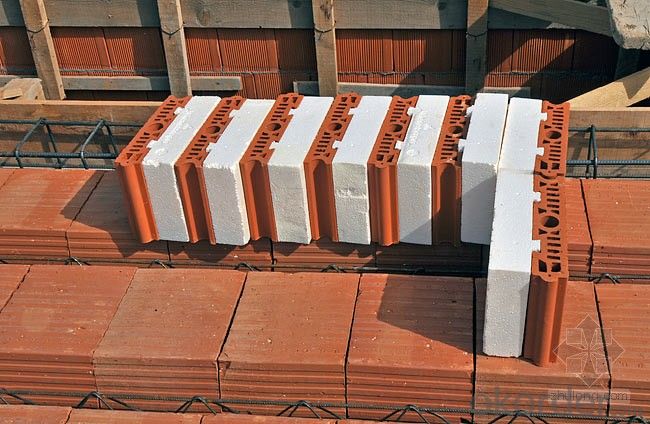
- Q: How do insulating fire bricks provide thermal insulation?
- Insulating fire bricks provide thermal insulation due to their low thermal conductivity and high porosity. The bricks are made from lightweight materials such as clay, alumina, or silica, which have low thermal conductivity. The high porosity of these bricks allows for the trapping of air or gas bubbles within their structure, which further reduces heat transfer. As a result, insulating fire bricks effectively minimize the conduction of heat, making them ideal for applications that require thermal insulation.
- Q: Can insulating fire bricks be used for sound insulation?
- No, insulating fire bricks are primarily designed for high-temperature applications such as lining furnaces, kilns, or fireplaces, and are not effective for sound insulation purposes.
- Q: Is it possible to recycle broken insulating fire bricks?
- It is indeed feasible to recycle damaged insulating fire bricks. These bricks are typically composed of recyclable materials like clay and alumina. After breaking, they can be crushed into tiny particles or ground into a fine powder. These fragments can then be blended with other substances to produce fresh bricks or alternative construction materials. Furthermore, certain recycling facilities may accept broken insulating fire bricks and repurpose them for use in various industries. By recycling these bricks, waste is minimized, resources are conserved, and the environmental consequences of manufacturing new bricks from scratch are reduced.
- Q: Can insulating fire bricks be used in cryogenic applications?
- Insulating fire bricks, also known as refractory bricks, are primarily designed for high-temperature applications and are commonly used in furnaces and kilns. However, when it comes to cryogenic applications, where extremely low temperatures are involved, insulating fire bricks may not be the most suitable choice. Cryogenic temperatures, typically below -150 degrees Celsius (-238 degrees Fahrenheit), pose unique challenges for materials due to the severe thermal stresses they experience. Insulating fire bricks are typically composed of materials such as alumina and silica, which have limited thermal shock resistance and can become brittle at very low temperatures. This brittleness can lead to cracking and failure when exposed to cryogenic conditions. Additionally, insulating fire bricks have relatively high thermal conductivity, which means they can conduct heat relatively well. In cryogenic applications, where minimizing heat transfer is crucial, materials with lower thermal conductivity are preferred. Therefore, insulating fire bricks, with their higher thermal conductivity, may not be the most efficient choice for cryogenic applications. Instead, materials with excellent thermal insulation properties and low thermal conductivity, such as aerogels or foams made from materials like silica or carbon, are often preferred for cryogenic applications. These materials offer superior thermal insulation and better resistance to extreme temperatures, ensuring the efficient and reliable performance required in cryogenic environments. In summary, while insulating fire bricks are suitable for high-temperature applications, they may not be the best choice for cryogenic applications due to their brittleness at low temperatures and relatively high thermal conductivity. Materials specifically designed for cryogenic conditions, such as aerogels or foams, are more suitable for these extreme temperature environments.
- Q: Can insulating fire bricks be used in the construction of flue gas ducts?
- Yes, insulating fire bricks can be used in the construction of flue gas ducts. These bricks are designed to withstand high temperatures and have excellent insulation properties, making them suitable for lining flue gas ducts where heat retention and energy efficiency are important.
- Q: Are insulating fire bricks resistant to phosphorus pentoxide?
- Yes, insulating fire bricks are resistant to phosphorus pentoxide.
- Q: How do insulating fire bricks help reduce heat loss through conduction?
- Insulating fire bricks help reduce heat loss through conduction by having low thermal conductivity. This means that they are poor conductors of heat, preventing the transfer of thermal energy from one side to the other. The bricks are made of materials with high porosity, which traps air within their structure. This trapped air acts as an insulator, minimizing the conduction of heat between the two sides of the brick. As a result, insulating fire bricks act as a barrier, reducing the amount of heat that is transferred through conduction and helping to maintain a more stable temperature.
- Q: Can insulating fire bricks be used in electric arc furnaces?
- Yes, insulating fire bricks can be used in electric arc furnaces. Insulating fire bricks are made of lightweight materials with high insulating properties, which make them ideal for applications where heat insulation is required. Electric arc furnaces generate high temperatures and require effective insulation to contain the heat within the furnace chamber. Insulating fire bricks can withstand the intense heat produced in electric arc furnaces, preventing heat loss and conserving energy. Additionally, their insulating properties help maintain a stable temperature inside the furnace, ensuring efficient melting and refining of metals or other materials. Therefore, insulating fire bricks are a suitable choice for use in electric arc furnaces.
- Q: Are insulating fire bricks suitable for outdoor use?
- Insulating fire bricks are generally unsuitable for outdoor use because they have lower density and higher porosity compared to other bricks. These bricks are specifically designed for high-temperature environments like furnaces and kilns, where they offer exceptional insulation. However, when subjected to outdoor elements, insulating fire bricks can absorb moisture and become susceptible to cracking or deterioration over time. For outdoor purposes, it is generally advised to opt for dense fire bricks or bricks explicitly made for outdoor use, as they possess superior durability and resistance against weather conditions.
- Q: Are insulating fire bricks suitable for use in carbon black furnaces?
- Yes, insulating fire bricks are suitable for use in carbon black furnaces. These bricks are known for their high insulation properties, which help in maintaining high temperatures inside the furnace while preventing heat loss. Additionally, insulating fire bricks are designed to withstand extreme temperatures and chemical reactions, making them a suitable choice for carbon black furnaces that operate under high heat and harsh conditions.
Send your message to us
Refractory mullite insulating refractory brick JM 93
- Loading Port:
- Shanghai
- Payment Terms:
- TT OR LC
- Min Order Qty:
- 5000 kg
- Supply Capability:
- 10000 kg/month
OKorder Service Pledge
OKorder Financial Service
Similar products
Hot products
Hot Searches
Related keywords
